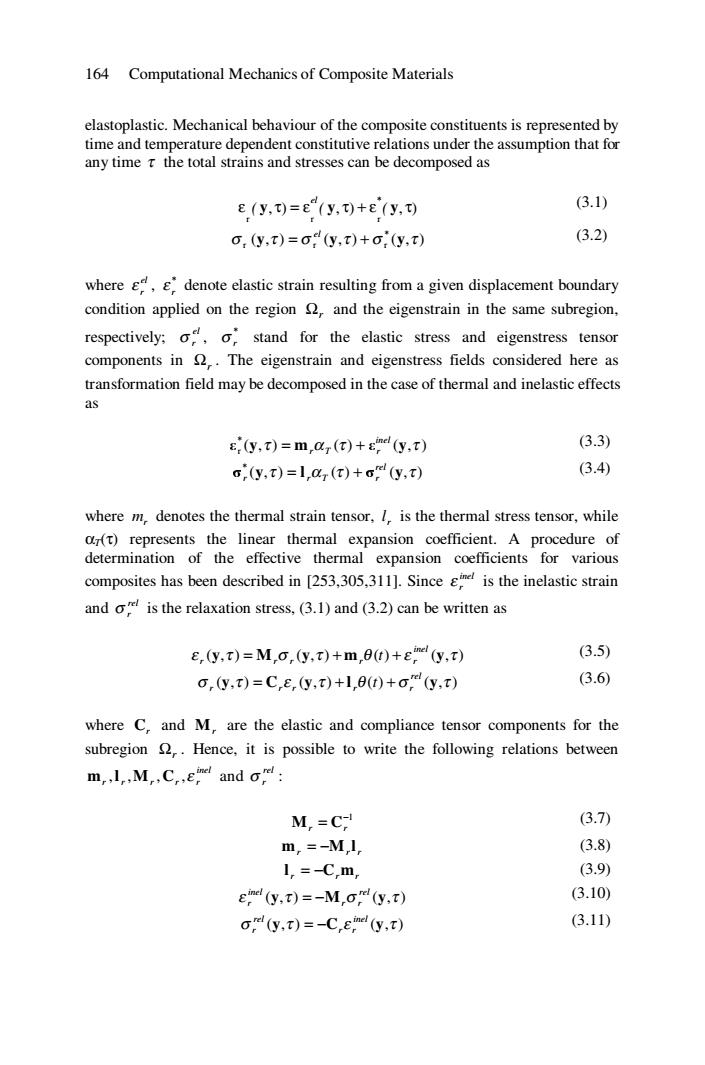正在加载图片...

164 Computational Mechanics of Composite Materials elastoplastic.Mechanical behaviour of the composite constituents is represented by time and temperature dependent constitutive relations under the assumption that for any time t the total strains and stresses can be decomposed as e(y,)=e(y,T)+e(y,) (3.1) o,(y,t)=o(y,t)+o,(y,t) (3.2) where e,denote elastic strain resulting from a given displacement boundary condition applied on the region and the eigenstrain in the same subregion, respectively:,stand for the elastic stress and eigenstress tensor components in The eigenstrain and eigenstress fields considered here as transformation field may be decomposed in the case of thermal and inelastic effects as y,t)=m,7(t)+n(y,T) (3.3) ,(y,t)=1a(t)+o(y,t) (3.4) where m denotes the thermal strain tensor,I,is the thermal stress tensor,while or(t)represents the linear thermal expansion coefficient.A procedure of determination of the effective thermal expansion coefficients for various composites has been described in [253.305.311].Since g is the inelastic strain and o"is the relaxation stress,(3.1)and (3.2)can be written as E,(y,t)=M,o,(y.t)+m,0(t)+gm(y.t) (3.5) o,(y.t)=C,E,(y,t)+1,0(t)+o(y.t) (3.6) where C.and M,are the elastic and compliance tensor components for the subregion ,Hence,it is possible to write the following relations between mMC and o M,=C- (3.7) m,=-M,1 (3.8) 1,=C,m, (3.9) Eimd(y.T)=-M,(y.t) (3.10) (y.)=-Cd(y.t) (3.11)164 Computational Mechanics of Composite Materials elastoplastic. Mechanical behaviour of the composite constituents is represented by time and temperature dependent constitutive relations under the assumption that for any time τ the total strains and stresses can be decomposed as , ) , ) , ) r r r ε ( y τ = ε ( y τ + ε ( y τ el * (3.1) ( , ) ( , ) ( , ) * r r r σ y τ = σ y τ +σ y τ el (3.2) where el r ε , * r ε denote elastic strain resulting from a given displacement boundary condition applied on the region Ωr and the eigenstrain in the same subregion, respectively; el σ r , * σ r stand for the elastic stress and eigenstress tensor components in Ωr . The eigenstrain and eigenstress fields considered here as transformation field may be decomposed in the case of thermal and inelastic effects as ( , ) ( ) ( , ) * r ε y τ m α τ ε y τ inel = r T + r (3.3) ( , ) ( ) ( , ) * σ y τ l α τ σ y τ rel r = r T + r (3.4) where mr denotes the thermal strain tensor, rl is the thermal stress tensor, while αT(τ) represents the linear thermal expansion coefficient. A procedure of determination of the effective thermal expansion coefficients for various composites has been described in [253,305,311]. Since inel r ε is the inelastic strain and rel σ r is the relaxation stress, (3.1) and (3.2) can be written as ε (y,τ ) M σ (y,τ ) m θ ( ) ε (y,τ ) inel r r r r r = + t + (3.5) σ (y,τ ) C ε (y,τ ) l θ ( ) σ (y,τ ) rel r r r r r = + t + (3.6) where Cr and Mr are the elastic and compliance tensor components for the subregion Ωr . Hence, it is possible to write the following relations between inel r r r r r m ,l ,M ,C ,ε and rel σ r : −1 Mr = Cr (3.7) r r r m = −M l (3.8) r Crmr l = − (3.9) ε (y,τ ) M σ (y,τ ) rel r r inel r = − (3.10) σ (y,τ ) C ε (y,τ ) inel r r rel r = − (3.11)